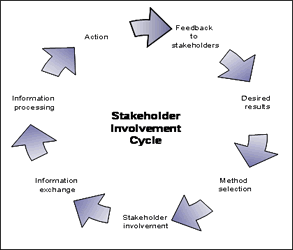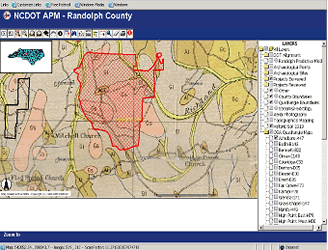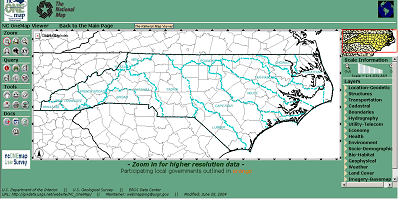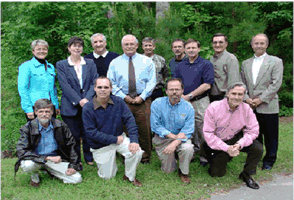CASE STUDIES
North Carolina: Environmental Stewardship Policy
Agencies and Organizations Involved
- Federal Highway Administration (FHWA)
- National Marine Fisheries Service (NMFS)
- U.S. Fish and Wildlife Service (USFWS)
- U.S. Environmental Protection Agency (EPA), Region 4
- U.S. Army Corps of Engineers (USACE)
- North Carolina Department of Transportation (NCDOT)
- North Carolina Department of Environment and Natural Resources (DENR), Division of Water Quality
- North Carolina DENR, Division of Coastal Management
- North Carolina Department of Cultural Resources
- North Carolina Wildlife Resources Commission
For additional information on integrated planning initiatives and environmental stewardship and streamlining efforts at NCDOT, please contact Julie Hunkins at jhunkins@dot.state.nc.us or (919) 733-1175.
Section 1: Overview
The Environmental Stewardship Policy signed by North Carolina’s Secretary of Transportation in 2002 is an integrated planning strategy for NCDOT. The policy supports North Carolina’s goal to plan, design, construct, maintain, and manage an interconnected transportation system while striving to preserve and enhance the State’s natural and cultural resources.
The policy refocuses NCDOT’s mission to provide an integrated transportation system that enhances the State’s overall well-being by encouraging all employees to practice environmental stewardship in their day-to-day activities. Championed by NCDOT leadership and incorporated into all facets of the agency, the policy has resulted in three particularly successful integrated planning applications. Merger01, the Ecosystem Enhancement Program, and the Integrated Transportation Planning and Project Development Process continue to change the way NCDOT is doing business in North Carolina.
Integrated Planning Applications
The first integrated planning application, the Merger01 process, was developed in two phases. Since 1997, North Carolina has applied a Section 404-NEPA [National Environmental Policy Act] Merger Process to its surface transportation projects. However, the overall process and original agreements were reevaluated in 2001 by multiple State and Federal agencies using experience gained since the 1997 agreements. These interim developments included guidance from a multi agency permit process improvement workshop and incorporation of the Federal environmental streamlining provisions of the Transportation Equity Act for the 21st Century (TEA-21).
The resulting process improvement initiatives, commonly known as Merger 01, streamlined the project development and permitting processes necessary to meet the regulatory requirements of section 404 of the Clean Water Act. Formal agency sponsors include USACE, DENR, FHWA, and NCDOT, while the process is supported by other stakeholder agencies and local units of government. As an early integrated planning effort, the Merger 01 process provided a forum for agency representatives to discuss and reach consensus on key project milestones during the NEPA and State Environmental Policy Act (SEPA) decision making phase of transportation projects.
Figure 1. The stakeholder involvement cycle is never ending.

Growing from the interactions and coordination of the Merger 01 process, the Ecosystem Enhancement Program (EEP) represents a key application of NCDOT’s Environmental Stewardship Policy. Using a systems approach, EEP integrates watershed and transportation planning, expediting delivery of transportation infrastructure projects while conserving, restoring, and enhancing North Carolina’s water resources. The program is a partnership between DENR and USACE for wetlands protection, mitigation, and enhancement programs. The purpose of EEP is to provide a comprehensive natural resource enhancement program that identifies ecosystem needs at the local watershed level and preserves, enhances, and restores ecological functions within the target watersheds while addressing impacts from anticipated transportation projects.1 Through coordination with EEP, NCDOT is able to identify wetland conflicts and opportunities early in the long-range planning process by using watershed plans.
The EEP concept is based on four fundamental goals: (1) mitigation is in place and meets established mitigation success criteria before transportation construction begins; (2) mitigation is linked to watershed planning, representing a programmatic approach rather than a project-by-project approach; (3) a single State agency is responsible for providing mitigation; and (4) mitigation is based on functional replacement rather than acres or feet of impact.2 While focusing on the first three goals, program participants are able to assess secondary and cumulative impacts on a given watershed and provide appropriate mitigation guidance. EEP has not devoted much attention to the fourth item, an initial goal that has not yet been addressed.
In North Carolina, the long-range planning process is called Comprehensive Transportation Planning (CTP). NCDOT is currently working on a process improvement project that will include each of FHWA’s 3-C planning principles (comprehensive, cooperative, and continuous), entitled the Integrated Transportation Planning and Project Development Processes. The purpose of this project is to develop a well-documented, integrated planning process that enables a seamless transfer of information about transportation needs and environmental and community considerations, allows appropriate decisions to be upheld, meets legal requirements, and is consistent with the Merger-01 process.3
A critical component of the integration project is development of a stakeholder involvement toolkit. The toolkit provides information related to different approaches for involving stakeholders, and guides users through the selection and implementation of a particular stakeholder involvement technique to achieve a desired result. Building from FHWA’s environmental review toolkit, the stakeholder involvement toolkit would allow users to know at which points in the long- range planning and NEPA processes to consider stakeholder involvement and which methods are best suited for the desired outcome of their involvement. The toolkit identifies the NEPA steps where stakeholder opinions should be considered. It addresses the complete communication cycle by indicating which outreach method to use, how to pass on information to stakeholders and receive feedback, and how to show stakeholders their input is used in making decisions.
The Integrated Transportation Planning and Project Development Process will result in completion of a new long-range, multi modal transportation plan; electronically accessible procedures manual; systems- level purpose and need framework; process to identify fatally flawed alternatives; and measurable performance goals.
Section 2: Data and Tools
Text Box: Figure 2. Screen Shot of the Archeological archeological Predictive predictive Model model User interface showing Data Layers

As a part of the increased emphasis throughout NCDOT to look for innovative tools and data-sharing methods, the geographic information system (GIS) unit within NCDOT began a project in 2001 to develop a GIS-based archeological predictive model to assess a project’s potential impacts to archeological resources very early in the planning process. Further, the tool allows project teams to quickly adapt reports to changes that occur throughout the life of a given project, including the addition of new corridors and/ or alternatives for study. Aside from the NEPA- driven rationale for using the archaeological predictive model, NCDOT benefits from a more realistic understanding of the scope, cost, and timeframe associated with the range of alternatives very early in the project planning process.
The data and inputs into the system resulted from a collaboration between NCDOT and the Office of State Archaeology (OSA) to digitize OSA historic records. The information and mapping capabilities contained in the GIS system will be available to other resource agencies, local planning agencies, and local governments as well.
Finally, NCDOT uses and contributes to the statewide GIS resource known as OneMap. This tool provides ready access to best available data, shares data across agencies using the best available technologies, and ultimately supports decision making at all levels of government in North Carolina.4 This mapping tool provides resource agencies, NCDOT, and particularly the general public with baseline data sets that can be used and continually updated throughout the project planning process.
Text Box: Figure 3. Screen Shot of the NC OneMap User Interface

Section 3: Scheduled Cooperation and Interaction Processes
Figure 4. Process flow showing NCDOT’s guiding principles for changing the culture

Building on momentum created by the Environmental Stewardship Policy, NCDOT created the Office of Environmental Quality (OEQ) in early 2003 to coordinate all activities related to environmental review for the Department. The office also serves as an internal environmental consultant providing advice for staff throughout the agency, and communicates information about environmental stewardship and streamlining efforts externally with resource agencies and the public.
Through internal training and education, OEQ has tried to build incrementally on current efforts that are sensitive to existing practices rather than introducing new and drastically different ideas and approaches. North Carolina has found that this approach minimizes resistance to change and leverages in-house experience and resources. OEQ developed and promoted a new training seminar, Context Sensitive Solutions: A Better Way, available to NCDOT employees involved in planning, project development, construction, operations, and maintenance. The sessions provide NCDOT staff with a systems-wide understanding of the integrated planning process within the transportation project life cycle. The course also focuses on helping employees better address environmental and community concerns while completing their day-to-day tasks.
Figure 5. Photo of North Carolina’s ILT
An OEQ representative participates on North Carolina’s Interagency Leadership Team (ILT). The team includes representatives from 10 Federal and State environmental resource agencies and focuses on finding innovative ways to balance mobility, economic vitality, and environmental protection. By meeting regularly at least once each month, the ILT has improved interagency communication, strengthened relationships, and increased trust between agencies at the senior level. The ILT helps each agency to better understand the goals and missions of the other agencies and identify issues as they arise.
Through a series of work sessions, the ILT has identified the top concerns and issues facing transportation, the environment, and economy in North Carolina. Those discussions helped form the mission and team goals.
- Goal 1: Develop a comprehensive, shared GIS database
- Goal 2: Local land use and long-range transportation planning result in projects that meet mobility, economic, and environmental goals
- Goal 3: Improve the Merger 01 process
Section 4: Legal Framework
In June 2001, the NCDOT Secretary and DENR Secretary signed an agreement signifying a shared responsibility to meet the State’s transportation needs while protecting its environment. The agreement outlines specific efforts that will strengthen the relationship between the two State agencies, including:
- Establishment of an elevation process to quickly resolve problems;
- Development of joint business plans;
- Monthly NCDOT/DENR senior staff meetings to address policy issues; and
- Sponsorship of process improvement workshops to improve the effectiveness and efficiency of NCDOT, DENR, and USACE permit development, coordination and issuance.
In concert with establishment of the Environmental Stewardship Policy, this agreement signified willingness by NCDOT to collaborate with other agencies to integrate transportation planning and environmental stewardship.
Two very important memoranda of understanding (MOU) established the legal and working framework for EEP. The first was a tri party agreement among the Wilmington USACE office, NCDOT, and DENR that established the legal standing for moving from project-specific mitigation to watershed-based, or programmatic, mitigation. The legal document also described the regulatory framework that would allow NCDOT to transition from construction of mitigation concurrent with or following road construction impacts to mitigation in the ground and fully functioning before road construction begins. This first MOU is the only one of the many signed that had actual binding requirements and legal standing in the EEP. The second MOU was a bi party agreement between DENR and NCDOT establishing the operational aspects of EEP. The MOU outlines the financial and operational responsibilities of the two agencies, ensuring DENR has the resources to provide mitigation and NCDOT has the mitigation needed to meet permitting requirements.
As part of streamlining the NEPA and section 404 permitting processes, NCDOT entered into a formal memorandum of agreement (MOA) with DENR in 1997. After several years of experience under the agreement, multiple State and Federal agencies joined together in 2001 to improve the merged NEPA/404 process established under the original agreement. The effort resulted in a new MOA and creation of the Merger 01 process.
Among other things, Merger 01 includes concurrence points, which are key milestones in the Merger 01 process. Concurrence is sequential and must be achieved in a set order to ensure that each project team member and the agency he or she represents agree to every decision made as the project develops. The seven concurrence points in the Merger 01 process are: Purpose and Need and Study Area Defined, Detailed Study Alternatives Carried Forward, Bridging Decisions and Alignment Review, Preferred Alternative Selection, Avoidance and Minimization, 30 Percent Hydraulic Review (a review of the development of the drainage design), and Permit Drawings Review.
Section 5: Leadership Role
Critical to our success was forging relationships at the upper-mid level and very senior leadership of our partner agencies. – Julie Hunkins, NCDOT
Recognizing the value and importance of environmental conservation and sustainability, NCDOT made environmental stewardship a top priority by infusing it into the culture of the organization from the top down. Strong executive support for integrated planning in North Carolina provided the mandate needed to change the way NCDOT planned projects, avoided and minimized impacts, and undertook the permitting process.
Using a top-down approach, NCDOT began to impart an environmental stewardship ethic into the organization by creating and filling the executive- level Deputy Secretary for Environment, Planning and Local Governmental Affairs position. Shortly thereafter, creation of the North Carolina Board of Transportation included the first Environmental, Planning, and Policy Committee to provide leadership, direction, and support for incorporating an environmental ethic at NCDOT. Finally, OEQ was charged with coordinating, facilitating, and promoting environmental stewardship and streamlining within the organization. Establishment of these positions demonstrated a commitment to environmental stewardship at the highest levels of NCDOT.
Leadership outside NCDOT has been assumed by the ILT, which meets to ensure that previously agreed-upon environmental strategies are being implemented effectively at each agency. ILT members also act as liaisons with their respective agencies, relaying information and upcoming meetings to other agency staff.
Section 6: Funding Sources and Liaisons
NCDOT, particularly OEQ, invests significant staff time and financial resources in environmental stewardship and streamlining efforts. Currently NCDOT funds 31 positions at other agencies in the State. These liaisons have proven necessary to ensuring continued interagency collaboration and the expediency that integrated planning requires. The positions cost NCDOT approximately $2.5 million per year.
In addition, NCDOT estimates that the process of developing an up-to-date and comprehensive 171-layer GIS system necessary for integrated statewide planning including land use, commerce, transportation, conservation, and other planning initiatives will cost roughly $45 million. Maintenance of the OneMap GIS system is estimated to cost an additional $4-5 million per year.
Mitigation efforts conducted under EEP also require NCDOT funding. These costs are not new, however, because prior to EEP they were reported within each project budget. As a result, the EEP funding process is the first comprehensive look at the overall cost of transportation project mitigation efforts.5 For fiscal years 2004-2005 and 2005-2006, NCDOT reported the total cost of EEP mitigation efforts to be more than $189 million.5 By separating mitigation costs incurred through EEP from overall project budgets, NCDOT estimates that it has saved money due to fewer project delays and greater financial accountability in project design.
Section 7: Performance Measures and Outcomes
OEQ publishes an annual work plan listing specific goals and targets for the upcoming year. These targets are grouped into overall office goals. The 2005-2006 and 2007-2008 Work Plans commit the office to targeting environmental stewardship and environmental streamlining efforts in tangible, attainable ways.
Since its founding in 2004, the ILT prepares and presents annual reports documenting progress toward its three key goals. The ILT also uses a Strategic Plan to guide development of solutions and outcomes. The document is available electronically to the public, and meetings minutes are posted to document performance measure status.
Section 8: Lessons Learned
North Carolina has focused much of its time and resources on creating a culture of change both within NCDOT and State resource agencies. This approach to integrated planning relies heavily on building trust and relationships between agencies and focusing on training the day-to-day practitioners within them. The agencies involved have only recently begun to use formal agreements and MOUs to document the informal understandings that have become part of doing business in the State. This legal framework is not yet in place, and will become increasingly important as staff turn over, agency leadership changes, and momentum slows.
Recently OEQ has begun to implement a system of performance standards to see whether the integrated planning approach in North Carolina has achieved the desired outcomes. There is also a need for data to assess the success of existing strategies and see how they can be improved. Performance measures could also result in a refocusing of NCDOT on newly identified problems and concerns as the integration process in North Carolina evolves.
1 Ross Jr., William G., Lyndo Tippett, and Charles R. Alexander, Jr. Memorandum of Agreement Among the North Carolina Department of Environment and Natural Resources, Carolina Department of Transportation, and United States Army Corps of Engineers, Wilmington District. July 2003.
2 D’Ignazio, J., B. Gilmore, C. Russo, K. McDermott. North Carolina’s Ecosystem Enhancement Program: Mitigation for the Future. Energy and Environmental Concerns 2005. Transportation Research Board, Washington, DC, 2005.
3 N C DOT Office of Environmental Quality. Comprehensive Transportation Planning Workshop Presentation. March 15 -19, 2004.
4 Transportation Research Board of the National Academies. Environmental Geospatial Information for Transportation. Transportation Research Circular Number E-C106. November 2006.
5 D’Ignazio, J., B. Gilmore, C. Russo, K. McDermott. North Carolina’s Ecosystem Enhancement Program: Mitigation for the Future. Energy and Environmental Concerns 2005. TRB, Washington, DC, 2005.

